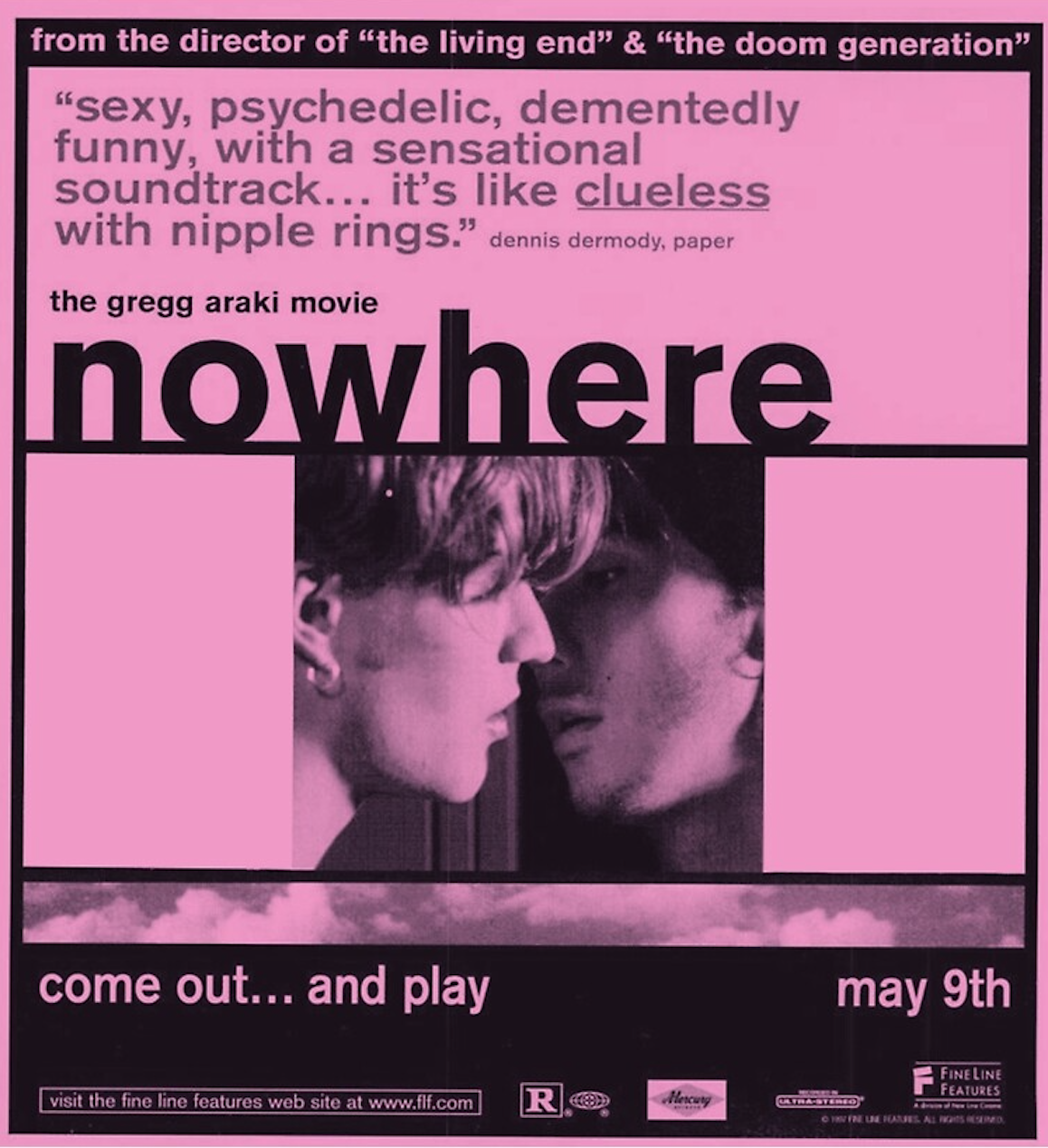Film Society x The Student: “Nowhere”
Staff writer Chris Tun ’25 reviews Gregg Araki’s very 1990s cool kid classic “Nowhere,” admiring its brutal honesty about the often disturbing experience of being young.

There comes a time when young people find themselves in a place that they don’t particularly want to be in. While it can be a physical location, it can also be more of a realm of being. It could be a party you really didn’t want to go to but went because of your friends. It could be an uncertain romantic relationship. It could even be the time after graduation when you don’t really know what your future looks like. Although this place isn’t unique to young people, it is a place that they frequently find themselves in as they enter a world of uncertainty without any form of guidance. It is a place in between that you can find yourself lost in.
In Gregg Araki’s 1997 film “Nowhere,” disaffected protagonist Dark (James Duval) says that Los Angeles is “like ... nowhere. Everybody who lives here is lost.” “Nowhere,” the third film of the Teenage Apocalypse trilogy, demonstrates Araki’s ability to tell a story of adolescence with characteristically vibrant visuals and sardonic dialogue.
Like the earlier films in the trilogy, “Nowhere” follows a group of teenagers as they go about everyday life, trying to ignore the doom that seems to await them all. They don’t do much besides hanging out or having sex. Dingbat (Christina Applegate) remarks that she seems to be the only one that actually goes to class even though they’re all college students. Apathetic to the world around them, they show no surprise at the bizarre happenings around them, from extraterrestrials intending to invade Earth to breakfast cafes in abandoned warehouses.
Although the film has little plot, you still get to know the characters and their anxieties. Dark is insecure about his relationship with Mel (Rachel True). He wants their relationship to be exclusive but Mel wants to continue their polyamorous lifestyle. He yearns for someone that can always be by his side, who ultimately arrives in the form of Montgomery (Nathan Bexton).
The other characters also have their own issues. Alyssa (Jordan Ladd) has fears about “the rapture,” which is brushed aside by her boyfriend Elvis (Thyme Lewis). Cowboy (Guillermo Diaz) is concerned that his boyfriend Bart’s (Jeremy Jordan) drug use will affect their relationship and his livelihood. Dingbat has a crush on Ducky (Scott Caan), and Zero (Joshua Gibran Mayweather) does not know how to get to Jujyfruit’s (Gibby Haynes) party (despite claiming he does to impress his girlfriend). By the end of the film, each character’s problems only get worse, reflecting the film’s nihilism.
Tonally, the film is everywhere. In one scene, two characters share an intimate moment. In another scene, someone’s nipple piercings are ripped off, evoking visceral horror in the audience. Nonetheless, Araki is able to navigate these shifts with a certain sensitivity.
Araki approaches the tragedy of two characters committing suicide with emotional awareness, making sure to avoid depicting it as just another chaotic event in the film. When Cowboy hears about his boyfriend’s suicide, he can hardly understand Bart’s parents as they cry and speak German. Yet the audience can see the reality of the situation wash over Cowboy’s face as he pieces together what has happened.
Similarly, Ducky can hardly hear his father reveal his sister’s suicide due to the volume of the party. Even though the audience doesn’t see his reaction, Ducky’s attempt to drown himself tells the audience so much about his relationship with his sister and the guilt he feels without us ever seeing it. With both the strange things that the characters encounter and more heartbreaking moments like this, the chaos of these characters’ lives is shown vividly as something that they cannot control, but some of this chaos eventually breaks through and evokes an earnest emotional response to both the characters and the audience.
Whether it is literal aliens kidnapping your crush or a group of carjackers taking your mom’s car, nothing makes sense in the Los Angeles of “Nowhere.” This is especially evident at the end of the film. After Montgomery escapes the aliens, he reunites with Dark in his bedroom. They share a heart to heart and reveal their attraction to one another. Although the audience assumes this is the hopeful ending they desire, Montgomery suddenly starts coughing and explodes to reveal a giant bug, leaving Dark covered in his bloody remains.
When I saw the film at Amherst Cinema, the lights came on right as this happened, leaving me in disbelief that this was the end of the film. Now, reflecting on the chaotic nature of the narrative and the characters’ lives, it would be more surprising if Dark actually got what he wanted instead of witnessing his crush explode into a Kafkaesque bug.
The film in itself is a reflection of 90s American pop culture, particularly television. Every character’s bedroom prominently features a TV. Dark, for example, uses this to edit his short films, and the audience even sees his ending video diary through the CRT screen of his television. For Egg (Sarah Lassez) and Bart, their TVs are essentially the last things that they interact with before their suicides.
Further demonstrating the pervasive presence of television in the film, Moses Helper (John Ritter) appears only on TV throughout the film. Ritter’s character is a televangelist whose pious words eventually lead to the suicides of Bart and Egg, who both were going through troubling times of drug addiction and sexual assault respectively.
Beyond these elements of the narrative, television is foundational to the idea of the film itself. In discussing the film, Araki describes it as “‘Beverly Hills, 90210’ on acid.” The cast even includes actors from popular teen dramas and sitcoms, like “Beverly Hills, 90210” as well as “Baywatch” and “Three’s Company.” Considering that Araki was also deeply invested in creating a show for MTV, television is fundamental to understanding the film.
Throughout the film, the cinematography and set designs are consistently visually engaging. The vibrant colors are reminiscent of Technicolor films like “Singing in the Rain,” with characters wearing color-coded outfits and a rainbow spectrum of dyed hair. There are many scenes that monochromatically illuminate the actors, which I find visually stunning. Bart is shown in vivid red and yellow lighting while he’s high, like a scene from a music video.
The set design associates certain colors with certain characters. Dark is surrounded by blue in many of his indoor scenes, like his room or the bathroom in which Mel breaks up with him. These sets add to a dreamlike quality to the film. Dark’s room feels like a stage, with its extremely high ceilings and window displaying an obviously painted view. The building in which the party takes place is similarly strange, with the warehouse exterior and seemingly domestic kitchen leaving the audience to guess how this building can exist in reality. These elements only further the chaos of the world these characters inhabit.
The film’s soundtrack, like other Araki films, reflect the interests of 90s youth. With artists like 311, Hole, and Marilyn Manson, the audience feels the angst and anger of our characters in their states of extreme lust or violence. In the scene in which Elvis brutally kills a man named Handjob, the harshness of “Dose” by Filter slowly escapes the background of the party into the foreground of the extremely violent attack conducted with a can of tomato soup. In contrast, the shoegaze and dream pop artists like Slowdive and Cocteau Twins highlight the ethereal environments. As Dark drifts back and forth between sexual fantasies while he takes a shower in the opening scene, “Avalyn II” by Slowdive perfectly complements the hazy cinematography, creating a dreamy atmosphere.
“Nowhere,” despite its initially mediocre reviews, is an important film for young people. While it can be disturbing and uncomfortable to watch, it’s brutally honest about the experience that youth go through, and validates their fears and anxieties about the future.





Comments ()